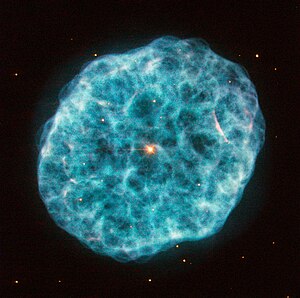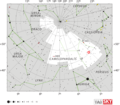NGC 1501
Appearance
| Emission nebula | |
|---|---|
| Planetary nebula | |
 As seen from the Hubble Space Telescope | |
| Observation data: J2000 epoch | |
| Right ascension | 04h 06m 59.39s[1] |
| Declination | +60° 55′ 14.4″[1] |
| Distance | est. 4,240 ly (1.30 kpc)[2] ly |
| Apparent magnitude (V) | 13.0[1] |
| Apparent dimensions (V) | 0.863' (diameter) |
| Constellation | Camelopardalis |
| Physical characteristics | |
| Radius | 0.5 ly ly |
| Designations | PK 144+6.1, PN G 144.5+06.5, GC 801, CS 14.4, H 4.53 |
NGC 1501 is a complex planetary nebula located in the constellation of Camelopardalis, discovered in 27 Aug 1787 by William Herschel.[2][3] It is also known as the Oyster Nebula.[4] The central star of the planetary nebula has a spectral type of [WC4], similar to that of a carbon-rich Wolf–Rayet star.[5] It is a pulsating star, meaning that its brightness varies regularly and periodically. In the case of NGC 1501's progenitor star, this is incredibly fast, with the star's brightness changing significantly in just half an hour. An analysis of Gaia data suggests that the central star is a binary system.[6] Visible-light observations capture the glow of gases including hydrogen and nitrogen.[7]
Gallery
-
The location of NGC 1502 (circled in red)
-
NGC 1501 from the 0.8m Schulman Telescope at the Mount Lemmon SkyCenter
References
- ^ a b c "SIMBAD Astronomical Database". NGC 1501. Retrieved 2014-11-09.
- ^ a b Sabbadin, F.; Benetti, S.; Cappellaro, E.; Turatto, M. (2000). "The tetra-lobed planetary nebula NGC 1501". Astronomy and Astrophysics. 361: 1112–1120. arXiv:astro-ph/0007039. Bibcode:2000A&A...361.1112S.
- ^ Seligman, Courtney. "Celestial Atlas: NGC Objects: NGC 1500 - 1549". cseligman.com. Archived from the original on 1 January 2016. Retrieved 10 July 2015.
- ^ "Hubble View of Bubbly Nebula". Retrieved 8 December 2016.
- ^ González-Santamaría, I.; Manteiga, M.; Manchado, A.; Ulla, A.; Dafonte, C.; López Varela, P. (2021). "Planetary nebulae in Gaia EDR3: Central star identification, properties, and binarity". Astronomy & Astrophysics. 656: A51. arXiv:2109.12114. Bibcode:2021A&A...656A..51G. doi:10.1051/0004-6361/202141916. S2CID 237940344.
- ^ Chornay, N.; Walton, N. A.; Jones, D.; Boffin, H. M. J.; Rejkuba, M.; Wesson, R. (2021). "Towards a more complete sample of binary central stars of planetary nebulae with Gaia". Astronomy & Astrophysics. 648: A95. arXiv:2101.01800. Bibcode:2021A&A...648A..95C. doi:10.1051/0004-6361/202140288. S2CID 230770301.
- ^ "Oyster Nebula NGC 1501 As Seen By Hubble - SpaceRef". spaceref.com. Retrieved 2021-02-08.
External links
 Media related to NGC 1501 at Wikimedia Commons
Media related to NGC 1501 at Wikimedia Commons- http://www.astronomy-mall.com/Adventures.In.Deep.Space/abellcat[permanent dead link]
- http://www.observing.skyhound.com/archives/dec/NGC_1501


